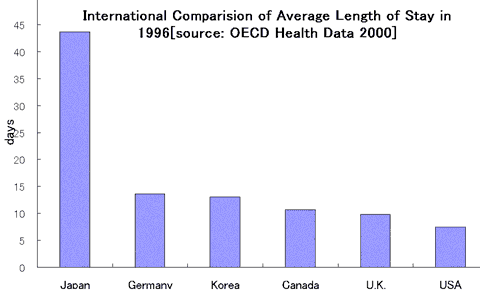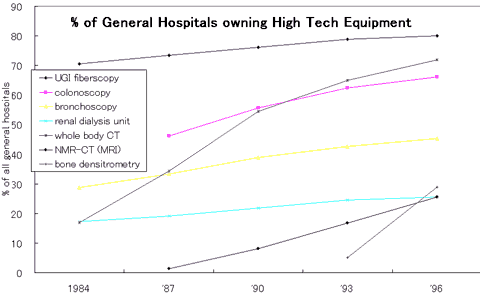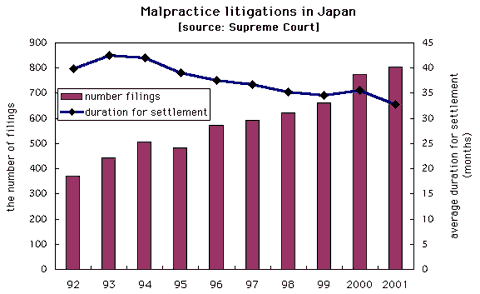|
Chapter 4 Medical Care |
| 1. General View of Japan's Health Policy |
|
Japan's medical care is characterized by ready access, free choice of providers and equality of treatment opportunities. These characteristics own much to its ubiquitous health insurance system that covers the entire population. Through the health insurance system, the price of every medical procedures as well as pharmaceutical price are under strict government control. Japan's great success in achieving one of the highest health standard in the world is no doubt the fruit of these strengths. However these seemingly satisfactory achievements of Japan's medical care has not been without problems. Lack of quality assurance mechanism, amenity of hospital wards and patients' right such as access to their medical records have been increasingly brought under criticism in recent years particularly after a series of serious malpractice cases had been exposed. Japan's health policy used to be that of laissez faire until 1985, when the Medical Service Act was amended for the first time in the postwar period to require prefectural governments to set up the regional health planning by which the prefectural governments can control the growth of hospital beds in the area with excess bed capacity. This was a bitter reflection over the traditional laissez faire policy that had resulted in a serious geographic maldistribution of medical care facilities and personnel. It was also part of cost control measures against spiraling health care cost. As of March 1998, the country is divided into 355 regions that controls the number of acute general hospital beds (psychiatric beds and TB beds are controlled at prefectural level, which numbers 47). Of these, 160 regions have excessive hospital beds than the objectively assessed number of necessary beds and henceforth are subject to restrictions on new hospital beds construction. |
| 2. Hospitals and Clinics |
|
The Medical Service Act delineates the medical care facilities as hospitals and clinics. Hospitals are further classified into acute general hospitals, psychiatric hospitals and tuberculosis hospitals and clinics are classified into medical clinics and dental clinics depending on the case mix of the patients they treat. It is noteworthy that a considerable number of medical clinics (nearly 20,000 in 1997) own inpatient beds up to 19. These clinics with beds effectively functioning as small sized hospital and their inpatient beds constitute approximately 240,000 beds out of 1.9 million beds (approximately 13%). The total number of inpatient beds in Japan as of October 1997 was approximately 1.9 million including approximately 240,000 clinic beds and 360,000 psychiatric beds. Acute general beds of hospitals are approximately 1.26 million or just 1% of the total population. These figures suggest that Japan has larger number of inpatient beds per population than most countries in the world by every means. Still, the number has somewhat declined from the peak of 1.95 million beds in 1990 thanks chiefly to the hospital bed control by the regional health planning enforced by the Medical Service Act. As of October 1997, there were 9,413 hospitals of all categories, more than 600 decline since its peak of 10,096 in 1990 reflecting mergers and acquisitions in recent years. There were approximately 90,000 medical clinics, of which 20,000 were clinics with 19 or less inpatient beds and the rest 70,000 were clinics without beds. The number of clinics with beds has been constantly declining while the number of clinics without beds has steadily increased. The ownership of hospitals and clinics in Japan is predominantly in private sector.�@However since the average size of national and public hospitals tend to be larger, public sector accounts for approximately 46% in terms of hospital beds. Ownership of private sector is either sole proprietorship or medical corporations (MC). MCs are special professional corporations incorporated pursuant to the Medical Service Act. MCs are similar to for-profit corporations in that they are established by direct investment from private shareholders but differ from for-profit corporations in that they are prohibited from disbursing profit to shareholders as a form of dividends. However the corporate asset of MCs are nonetheless the shareholders' property and they are entitled to claim refund at its market value anytime. MCs are also subject to more regulations and supervision by the regulatory authority as to their business and operations than ordinary for-profit corporations. In general, for-profit corporations are prohibited from owning and operating hospitals and clinics based on the so-called "not-for-profit" principle presumably dictated by the Medical Service Act. This "not-for-profit" principle was somewhat eased in the field of home care in the Long-Term Care Insurance system but is strictly adhered in the field of medical care and institutional LTC despite strong call for deregulation mainly from industry side. Japanese hospitals are in general well equipped: two out of three hospitals including psychiatric and tuberculosis hospitals have whole body CT scan. The percent of hospitals that own high-tech medical equipment is: NMR-CT (MRI) 23%, angiography 27% and UGI fiberscopes 72% (Health Care Facilities Survey as of October 1998). This dissemination of high-tech equipment may be beneficial to patients but may not be favorable in health economics viewpoint. Disseminating these high-tech equipment in a cost-effective manner while securing easy access to patients will be difficult but important health policy issues. Japan's inpatient care is characterized by prolonged length of stay: 43.7 days overall (32.8 days for acute general beds and 423.7 days for psychiatric beds). See the graph below  |
| 3. Accreditation Program of Hospitals and Clinics |
There has been no formal accreditation program to evaluate and certify hospitals and clinics in Japan until 1997, when Japan Health Care Accreditation and Certification Organization started its official accreditation program. Accreditation is voluntary and hospitals that would like to undergo accreditation must apply and pay the accreditation fee. As of May 1999, 206 hospitals were accredited as satisfying the standards set by the organization. |
| 4. Patient safety and medical malprac |
Safety in medical care is increasingly drawing public attention almost in parallel with patients' awareness of their right. Japan has long been considered as non-litigious society but an alarming increase of the number of medical malpractice related litigations filed every year suggests a rapidly occurring transformation of both societal atmosphere and patients' attitude. MHLW has long taken a "hands-off" stance about medical malpractice and negligence on the basis that they are basically civil disputes, which should be settled among concerned parties. However a series of serious accidents disclosed at major medical centers have prompted the government to intervene as a precautious measure. Effective in October 2002, the Medical Service Act will be revised to require that all hospitals as well as clinics with inpatient beds to take necessary precautious measures including a guideline to secure safety, reporting system from employees about any potentially dangerous pitfalls in daily operation and training and monitoring about safety. Particularly, academic medical centers will be required to appoint a full-time "risk manager" both for prevention of accidents and taking appropriate actions in case any claims are brought up patients. Still there is no officially mandated reporting system of any incidence and, therefore, the actual number of such incidence is open to guessing. The Physicians Act mandate that the doctor shall report to police when the patient dies of unexpected causes, but there is no mandatory reporting of incidence that fall short of death. |
  
|